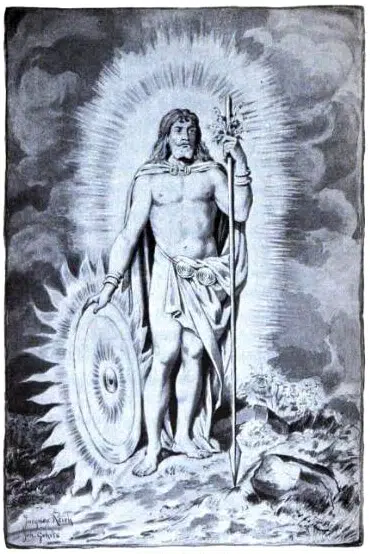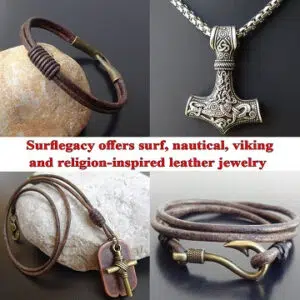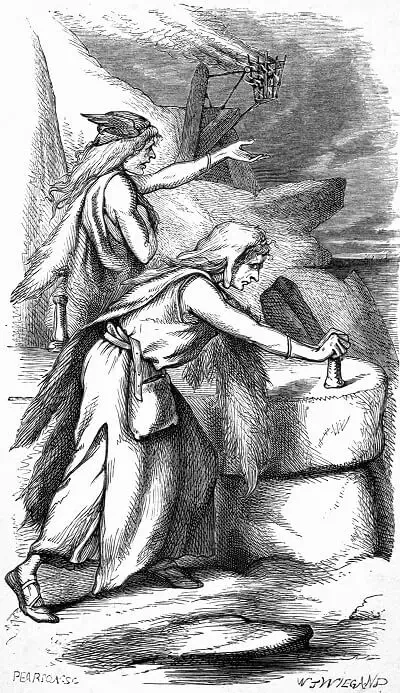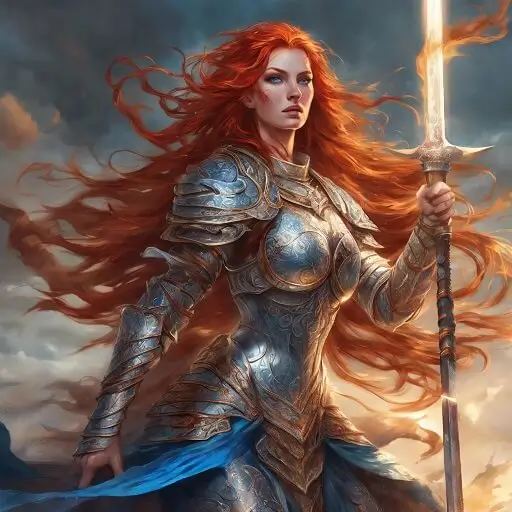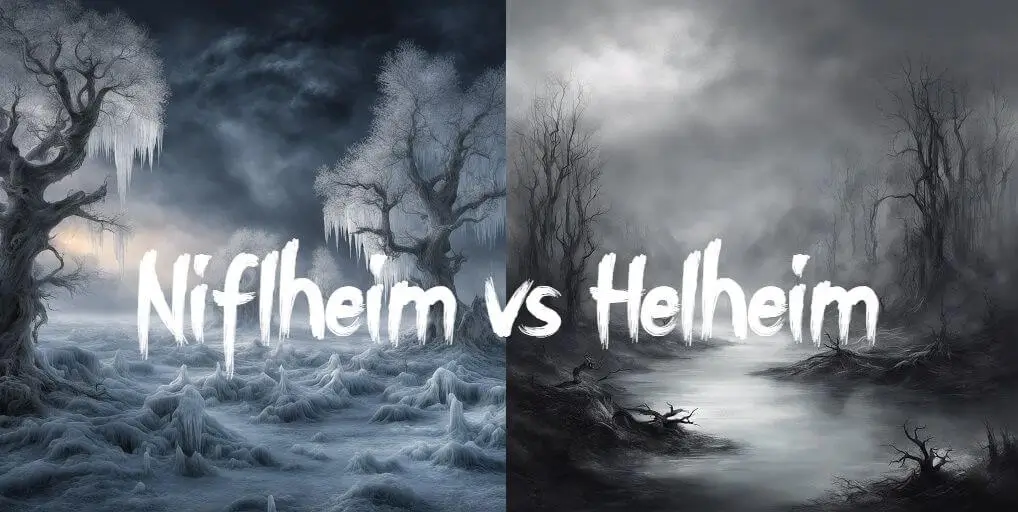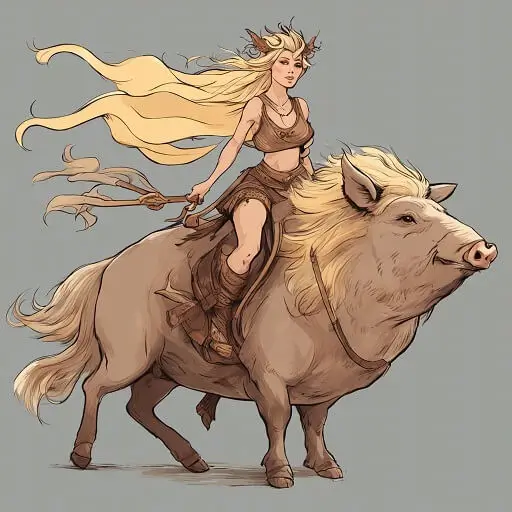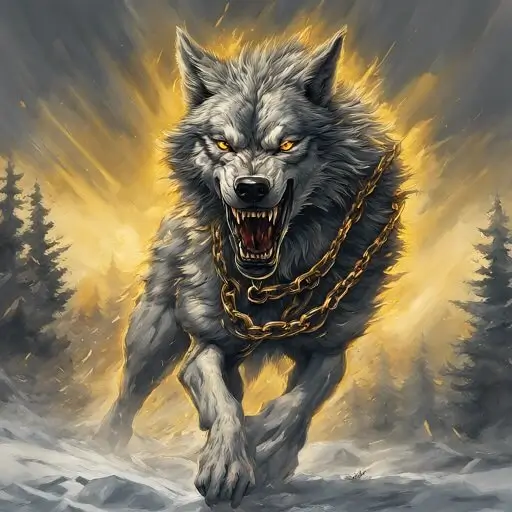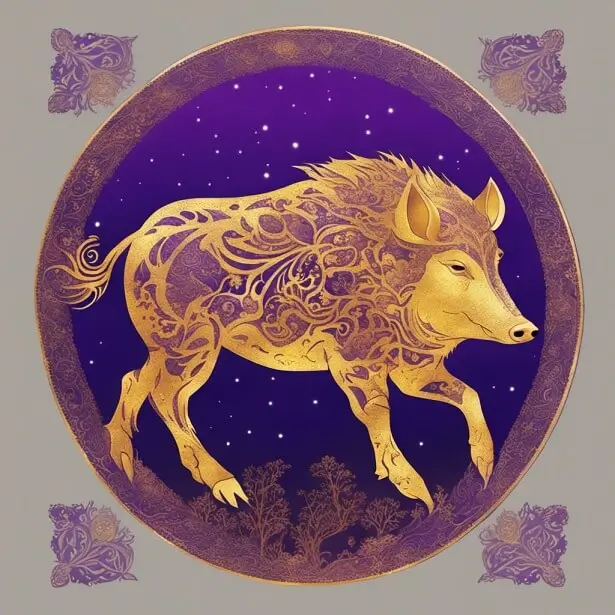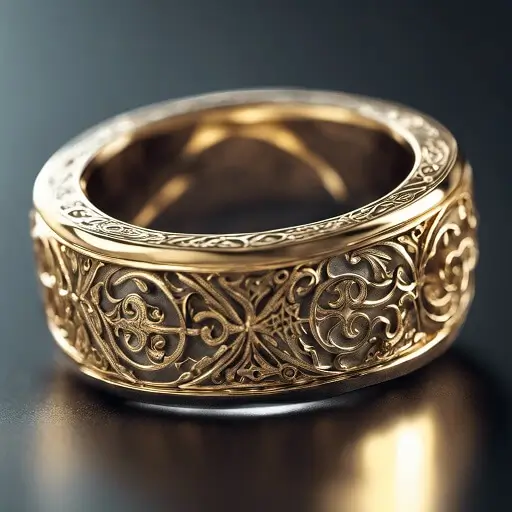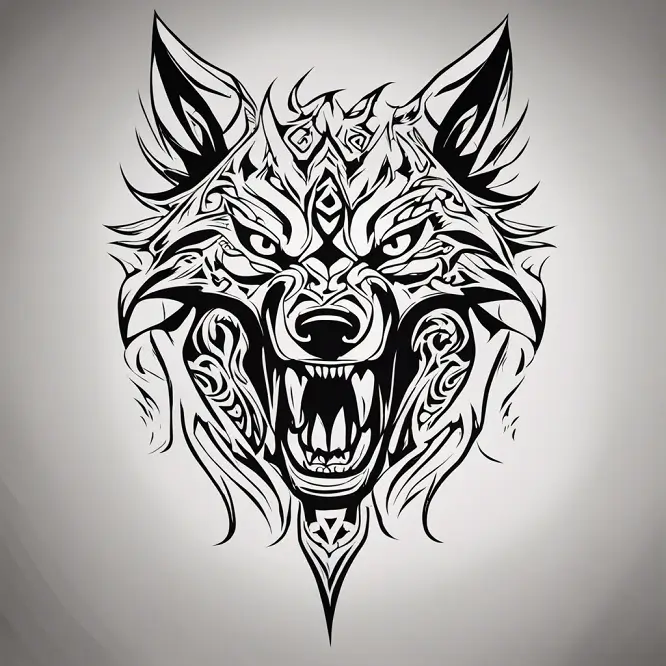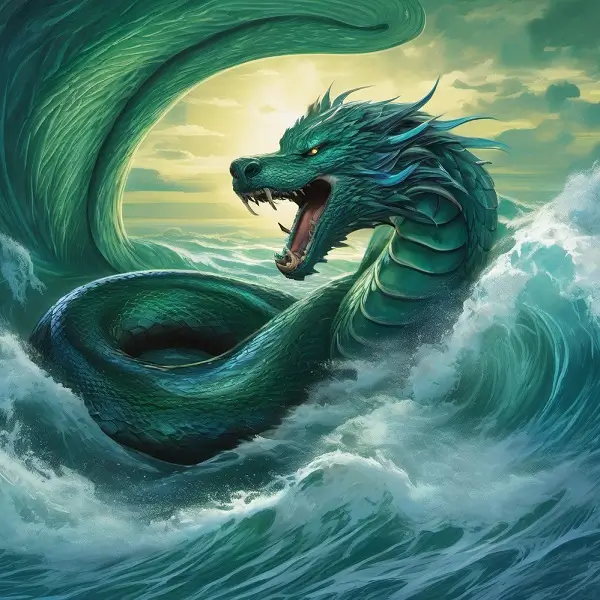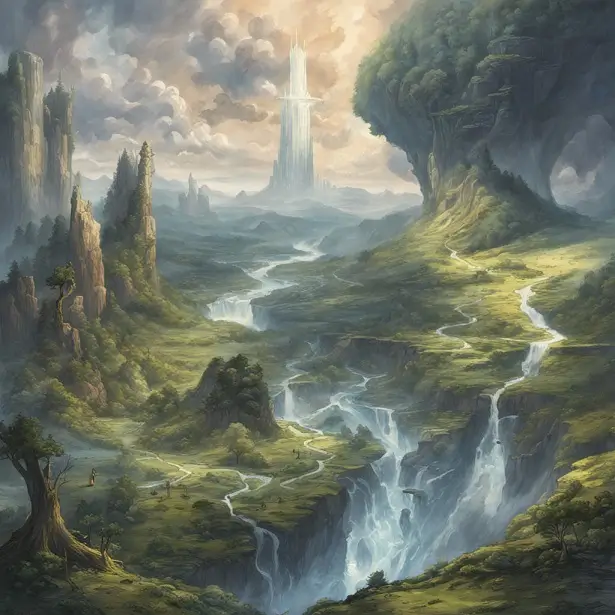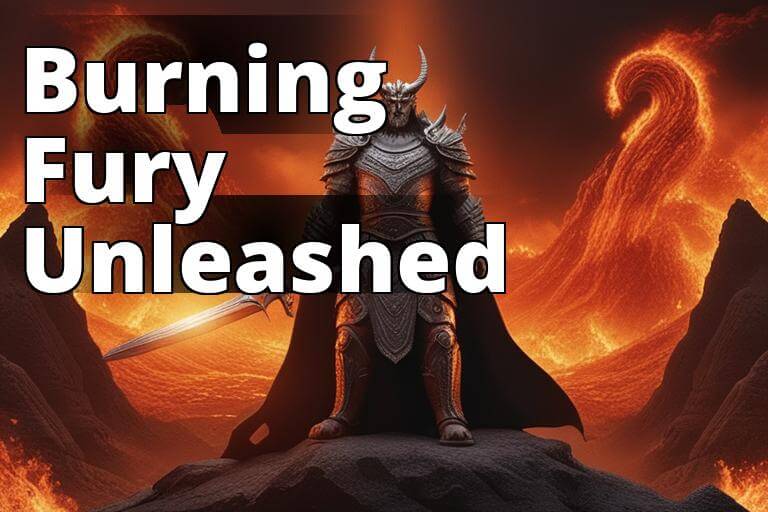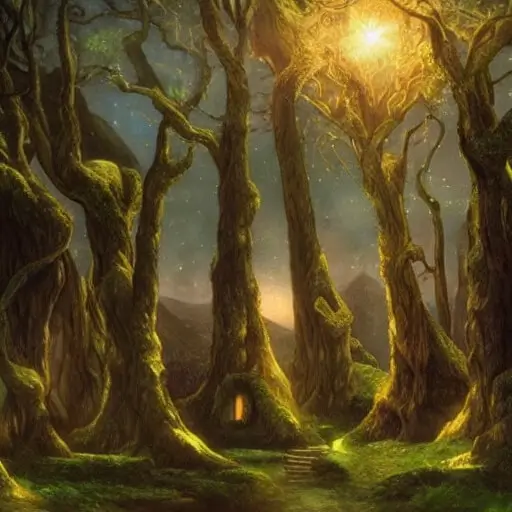Baldur (old Norse Baldr) is the son of the chief god Odin and his wife Frigg. He is associated with light, wisdom, and courage.
From his heroic death to his enduring legacy, there is much to explore about this fascinating figure from Norse mythology. In this blog post, we will take a deep dive into Baldur’s life and legacy.
Baldur, the Son of Light
Baldur was the personification of the sun and light, so he was represented as a young man bright, with snow-white hair and radiating light.
He is also celebrated as the most beautiful and the wisest of the Aesir Husband of Nanna, goddess of which, we know very little from the Edda, the tales of Norse Mythology written by Snorri Sturluson in the XIII century
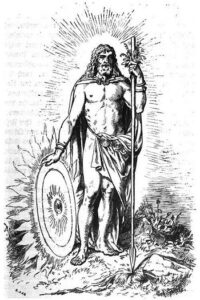
Baldur by Johannes Gehrts
Husband of Nanna, had a son named Forseti, the god of justice and reconciliation. This detail, along with the fact that the same Odin and Frigg were described as the gods of wisdom and intelligence, supports the thesis that Baldur could also be the god of intellect.
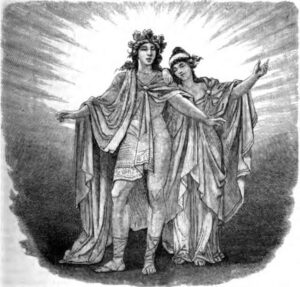
Baldur and Nanna
It was said that from Odin he had inherited the Draupnir ring, forged by the Dwarfs, which had the ability to increase the wealth of its possessor and to multiply itself every 9 days for eight times.
Baldur and Forseti were two benevolent deities, both represented as shining. Of Baldur, above all, it was said that he had the purest heart of all the gods, and that he lived in the Breidablik a shining place located in the sky, where nothing impure could reach.
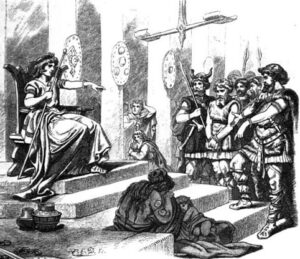
Forseti Norse God of Justice
On the other side, Hodur (old Norse “Höðr”), Baldur’s brother, represented the god of war and discord, and was, therefore, a more malevolent god. Unlike Baldur, who radiated light everywhere, Hodur was blind from birth, and therefore perpetually shrouded in darkness, a symbol of aggression and inability to mediate.
Moreover, because of his blindness, Hodur was often left aside by the other Aesir and did not participate in the convivial moments of the other gods, a fact that emphasized, even more, his inability to dialogue.
Baldur was also described as the favorite son of Frigg, the Queen of Asgard. This detail may derive perhaps from the fact that Baldur was the symbol of the sun, that is one of the stars of the sky, or perhaps from the fact that the light from which he was surrounded represented his power of clairvoyance, the gift of which Frigg was also said to possess.
The death of Baldur and Ragnarok
The myth of Baldur was mainly related to that of the end of the world, the Ragnarök, during which it was said that there would be a short dominance of evil over the forces of good. In fact, it was told of the premature death of Baldur as an omen of death and destruction of the world, as well as an event anticipating the death of almost all the gods during the Ragnarök.
It is said that Baldur was plagued by nightmares, then Odin, his father, worried about these dreams questions the Volva, the seer, awakening her from her eternal sleep.
The Volva reworks Baldur’s dream interpreting it as the foreshadowing of the death of the god and that in the world of Hel, the goddess of the dead, everything is ready to welcome Baldur, because this god is destined to die.
Everyone is worried about this prophecy because Baldur is seen as a beautiful, wise and good god, so the news of his imminent death throws everyone into despair. In order to prevent the occurrence of such an event, Frigg made all creations take a solemn oath to never harm his son Baldur in any way.
The only plant that did not take the oath was a young mistletoe bush, either because it grew in a place too dark and far away to be seen, or because it was considered harmless by the goddess herself.
Having become invulnerable, Baldur continually challenged the gods to hit him in turn with any object, to demonstrate his strength and his disregard for danger, sure that no one would be able to scratch him. In particular, these games took place during times of gathering between gods, which Hodur could not attend.
On that occasion, the god Loki – perhaps out of jealousy or driven by his evil nature – took the opportunity to kill Baldur with the help of Hodur: with the excuse of helping him to take part in the games, Loki convinced Hodur to shoot with his bow, towards his brother, the sprig of mistletoe that had escaped the solemn oath (of whose existence Loki had learned from Frigg disguised as a maid) causing the instant death of Baldur.
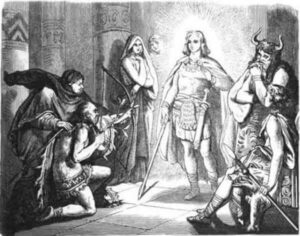
Death of Baldur
After the death of the latter, his wife Nanna also lost her life for the great pain, and together with her husband was placed in the same tomb by Odin, and then go to occupy the infernal pit presided over by Hel. It is said that, before the deposition, Odin whispered in the ear of his son some mysterious words that were never heard or passed on by anyone.
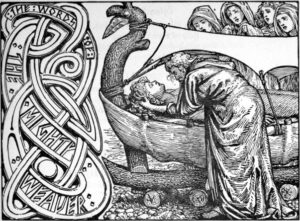
Odin’s last words to Baldur
Attempts to bring Baldur back to life were useless, such as the attempt of mediation with Hel by Hermod called “the brave”, another of the sons of Odin.
To Hermod, Hel promised to bring Baldur back to life only if all living beings, mortal or immortal, had sincerely mourned his death, but Loki, in the guise of the giantess Thokk, refused to shed tears for him, making that the god could not resurrect.
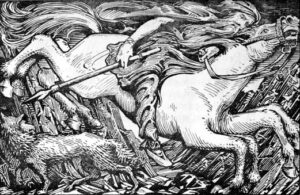
Odin rides to Hel Baldur
As punishment for the incident, Hodur was killed by Váli, one of the illegitimate sons of Odin, while Loki was tied to a rock and forced to terrible torture, that is to be corroded in the face by a poisonous snake.
After the death of Baldur began a winter three years long, very hard, a period of great crisis, wars, famine, pestilence, internal struggles within the same families and the outcome of this period will lead to Ragnarok, announced by the horn of Heimdall: the ranks of evil led by Loki, will face the ranks of good led by Odin.
Everyone will have a rival: Thor will fight against the serpent Jormungand that wraps the world son of Loki, the fire giant must fight against Freyr, who is not familiar with the sword, Odin will fight against the wolf Fenrir, also son of Loki. No one survives, all are destined to perish.
How Did Baldur Beat the World Serpent?
In order to beat the World Serpent, Baldur used his magic sword to cut off its head. However, Kratos and Atreus were able to retrieve Mimir’s other magic eye from inside the World Serpent. This allowed them to see what was happening in the other realm and eventually defeat Baldur.
The meaning of mistletoe in the myth of Baldur
The only object able to kill him was perhaps considered among the most sacred of the cultic plants ever.
The invulnerability of the god would thus be linked to the symbiosis parasitic plant-oak tree: only depriving the sacred tree of its protection, the mistletoe, in fact, would allow its incineration. Only hitting the god with the mistletoe would cause his death and subsequent cremation.
However, It is well known, that in the countries of the far north of Europe it is very rare to come across mistletoe.
Certainly, in Iceland, there is no trace of it, while in the Scandinavian countries it is present only in the southernmost regions. It is also worth asking why mistletoe was chosen as the weak point of a deity.
According to Frigga, mistletoe grew west of Walhalla, and was considered too young to be a danger for Baldur. And in fact, it is difficult to imagine turning a slender plant like that into a lethal weapon.
The explanation could lie in a linguistic error on the part of the myth’s creators. According to this theory, the Scandinavians would have learned about the incredible properties of mistletoe from their contacts in the west, with Great Britain, where there was an abundance of it, and would have imported the knowledge into their countries.
So the word used in ancient English for mistletoe, mistelstan, was transposed to mistilteinn, which in ancient Norse would mean “deadly weapon”. It is therefore probable that originally the plant used in the myth of Baldur was another one and then it became mistletoe later.
Baldur and Jesus’ similarities
However, there is also a happy ending to the story: it is said that Baldur – together with Nanna and her brother Hodur – will be resurrected after Ragnarok, together with the children of the god Thor.
The god who dies, whose death prefigures the twilight of the gods, is an entirely Norse invention and gives the impression of having been modeled on the passion and death of Jesus, the figure of a sort of Messiah loved by all, who sacrifices himself for all, immolates himself for humanity, a divinity who is then reborn, because at the conclusion of the Voluspa, the first carol of the Edda.
This in fact presents a great overview of the History of mankind:
- the birth of the giants;
- the dismemberment of the primordial giant, whose body parts are used to create the cosmos;
- the birth of the first man and the first woman;
- the birth of all the divinities;
- the war between Asi and Vani;
- the Ragnarok.
All these myths end at some point in the Voluspa’s carol, whose verses refer to the rebirth, the birth of a new era where the old deities are no longer there.
There is only Baldur who is reborn, the only one who becomes, in essence, the progenitor of a new society, the only deity who has the right to exist in this new era in which probably the new religion is accepted, the Christian religion, where we will find Baldur reconciled with his killer, where there is a reference to rebirth and there is a man and a woman, a couple, ready to start again.
So the idea of a God who not only dies but at some point is reborn after having been for a time in the underworld, just as it happens to Jesus for three days, his rebirth represents the rebirth and redemption of all humanity.
After all the cult of Easter is seen as a rite of passage, not by chance it is in spring and for this reason the myth of Baldur is seen as a fertility rite of the goddess Nerthus.
Other similarities we can find are:
- the enmity of Loki, who represents the devil;
- the permanence for a limited period of time in the underworld (in this regard we remember that there is an Apocryphal Gospel, the one of Nicodemus, in which it is referred to the idea that Jesus, in the three days spent in the underworld, would have gone to free the patriarchs and prophets who died before his coming in order to save them and let them access to Paradise).
There are also other figures modeled on the Judeo-Christian tradition, for example, Hodr, the unaware protagonist of Baldur’s death who throws the mistletoe twig that becomes an arrow.
He in his blindness depicts a pagan replica of Longinus, who pierces the side of Jesus with a spear: it seems that he too was deprived of sight.
The same idea of the weeping that Hel demands from all the realities of creation is an emblem of the prayers of suffrage that the living must grant to the dead to ensure their resurrection on the day of judgment.
Baldur and Osiris
One of the myths to which the story of the god of light, Baldur, most closely resembles is that of the Egyptian god Osiris, who was also killed by his brother (named Seth) and then brought back to life by his bride and sister Isis.
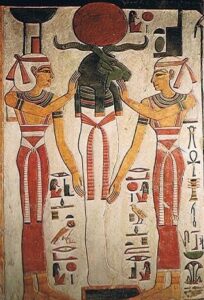
Osiris
The similarity between Osiris and Baldur is greater when one considers that both were destined to be avenged by a relative. Once resurrected, in fact, Osiris conceived Horus, destined to avenge the death of his father and bring him back to earth (although alive again, in fact, Osiris is not allowed to return to the realm of mortals).
Horus, in this case, would have an analogy with Váli, the half-brother who killed Hodur, the murderer of Baldur.
The question as you can see is still open, the death of Baldur the Bright is destined to be debated for a long time to come.
Buy Norse Jewelry
Are passionate about Old Norse Mythology? Finding the ideal piece of Norse Jewelry can be challenging and time-consuming, especially if you lack inspiration or don’t know where to look.
At Surflegacy, we have a wide range of Norse Jewelry in various styles, shapes, colors, and materials, to accentuate your Viking spirit and look. Visit our shop here
If you are passionate about Norse Mythology do not hesitate to visit our store for more handmade Norse Jewelry.

